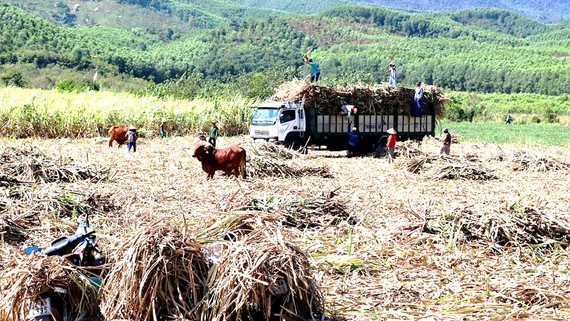
Harder to make a living with sugarcane
The harvest of sugarcane in sugarcane growing-areas in Ninh Xuan and Ninh Tay communes in Ninh Hoa Town was quite subdued. Many sugarcane fields are stunted and unhealthy because farmers neglect to invest in care. Interlaced between stunted sugarcane fields is vacant land. The sugarcane growing-areas in Ninh Hoa no longer show the lush green of the heyday of sugarcane. Even in the harvest season, the gloomy atmosphere hovers over sugarcane fields. According to local sugarcane farmers, the current price of material sugarcane purchased by local sugar refineries ranges from VND920,000 to VND950,000 per ton for sugarcane with 10 percent of commercial cane sugar. This is considered a high price compared to those in recent years, but farmers are not as excited as the time when sugarcane helped them to make a fortune. For instance, in Ninh Tan Commune, five years ago, sugarcane helped many farmers to escape poverty and become well-off, thanks to large-scale sugarcane cultivation. However, in recent years, sugarcane has no longer brought them a prosperous life anymore. Visiting the 1.5-hectare sugarcane field of Vo Thi Hau Phuong, a farmer in Trung Village in Ninh Tan Commune, whose sugarcanes are of high quality in the area and are being harvested to sell to the factory of Vietnam Sugar Company, she said that in this crop, sugarcane yield was about 40 tons per hectare, with commercial cane sugar percentage at above 10. It is because her family invested and taken care of their sugarcane field carefully. Meanwhile, many surrounding stunted sugarcane fields will undoubtedly give very low productivity. Despite high yield, high commercial cane sugar percentage, and high sugarcane selling price in this crop, she reckons that the profit is small. Le Minh Tuan's household in Bac Village in Ninh Tan Commune has more than 3 hectares of sugarcane. With nearly 20 years of experience in growing sugarcane, he estimated that the total output would be over 100 tons. With the current price, the profit is not very high, just enough to cover daily expenses. “After this crop, my family will lease a part of the land, or temporarily find more suitable crops. If there is no more suitable crop, I will grow acacia hybrid, because, with such a situation, it is difficult to cling to sugarcane any longer”, Tuan said.Finding ways to switch crops Originally, Ninh Hoa was "the capital of sugarcane", the pride in the agricultural structure, but now many local farmers have decided to switch to other crops, or reluctantly leave their fields uninhabited. According to Mr. Vo Ngoc Phi Vu, Chairman of the People's Committee of Ninh Tan Commune, sugarcane cultivation is no longer effective, so the area of sugarcane in the commune has continuously decreased sharply. The whole commune has only 500 hectares of sugarcane in this crop, a decrease of 800 hectares compared to the 2018-2019 sugarcane crop. As explained by the leader of Ninh Tan Commune, there are many reasons for ineffective sugarcane cultivation. Particularly, climate change, unusual weather, and floods affected the productivity and quality of sugarcane. Besides, sugarcane farmers also faced many difficulties, such as scarce labor, high sugarcane transporting cost, while sugarcane prices were at low levels. As in the 2017–2018 crop, the buying price of sugarcane was only at VND780,000 per ton, causing heavy losses for farmers. He said that the commune was concerned about which suitable crops to direct and encourage farmers to switch to because sugarcane was the key crop in the past. Currently, it was waiting for directions from the superiors. Many farmers in Ninh Hoa Town have actively converted some sugarcane growing-areas to other crops. However, the crop conversion has not been synchronous, so it cannot be the fundamental solution to develop specialized agricultural areas to replace sugarcane, which is in decline. Mr. Phan Thanh Liem, Vice Chairman of the People's Committee of Ninh Hoa Town, said that sugarcane is no longer bringing economic benefits to farmers. It shows clearly when in the 2020-2021 sugarcane crop, the whole town only has 6,200 hectares of sugarcane, while it was about 8,200 hectares before. Amid the situation that sugarcane fields were left uncultivated, Ninh Hoa Town has had a plan to rezone the soil map, aiming to change the appropriate crop structure, thereby promoting calling for investors to link cooperatives to convert inefficient or vacant sugarcane areas to new crops.
In the 2020-2021 crop, Khanh Hoa Province has more than 12,790 hectares of sugarcane, while it was nearly 20,000 hectares in the 2016-2017 crop. Currently, the provincial Department of Cultivation and Plant Protection has advised the provincial Department of Agriculture and Rural Development to submit to the People's Committee for approval of the crop conversion plan for the 2021-2025 period to have a basis for the department to develop support policies for farmers.
























